Bài giảng Introduction to Computer Programming (C language) - Chapter 2: C Program Structure and its Components - Võ Thị Ngọc Châu
Content
Introduction
A Sample C Program
Coding Styles
Data and Standard Output Function
Data and Standard Input Function
Data Processing: Simple Example
Summary

Trang 1
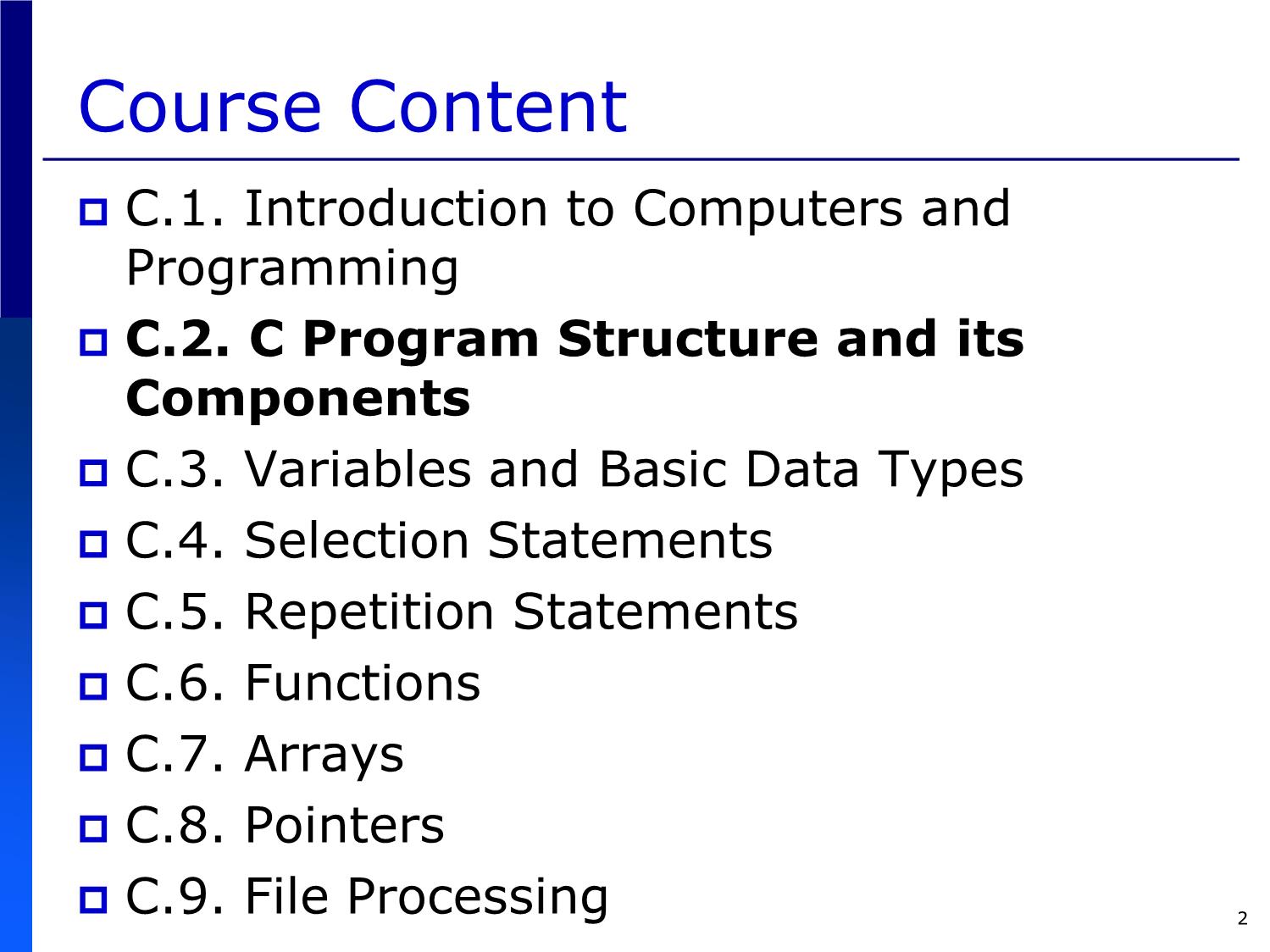
Trang 2
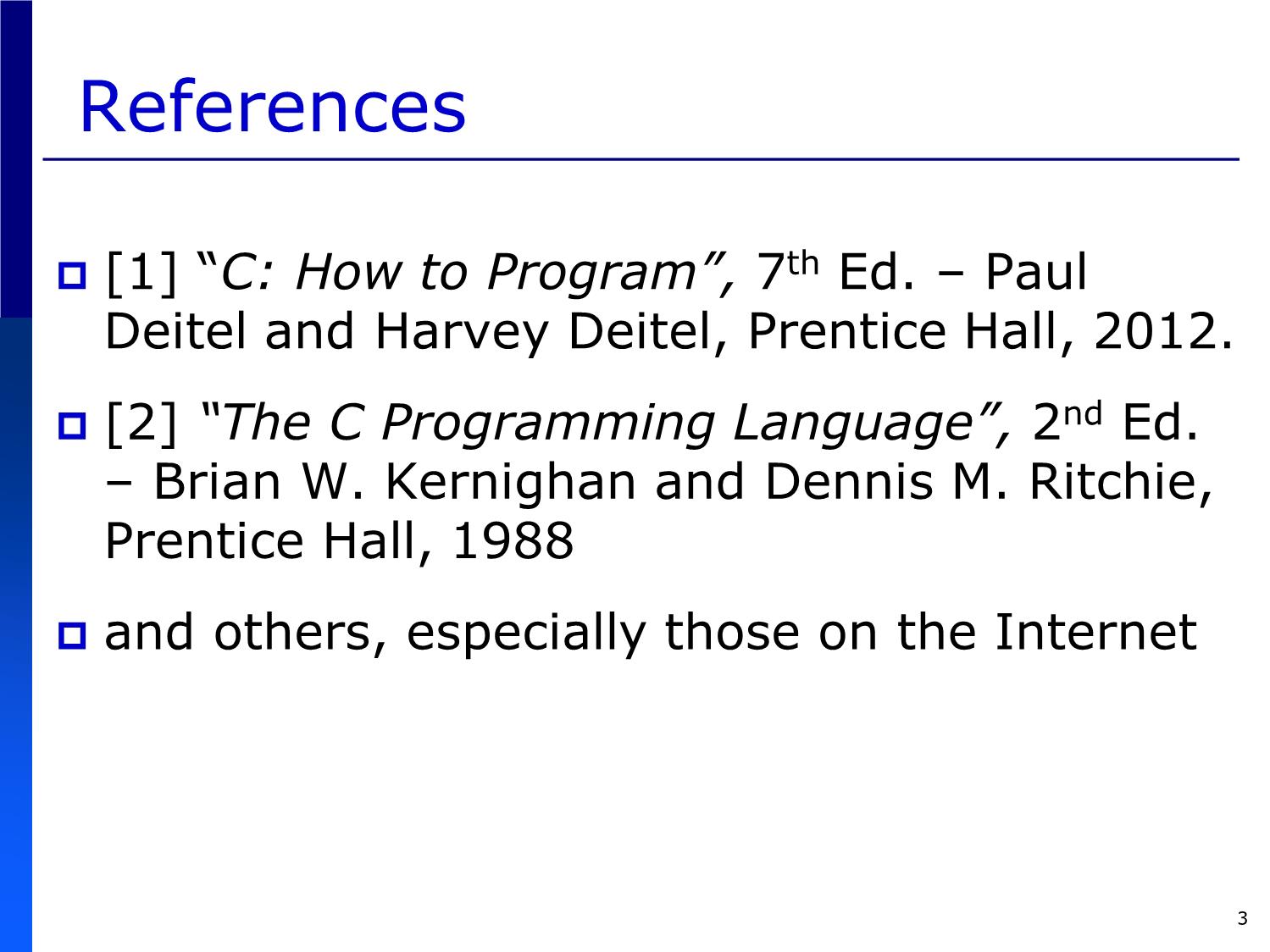
Trang 3
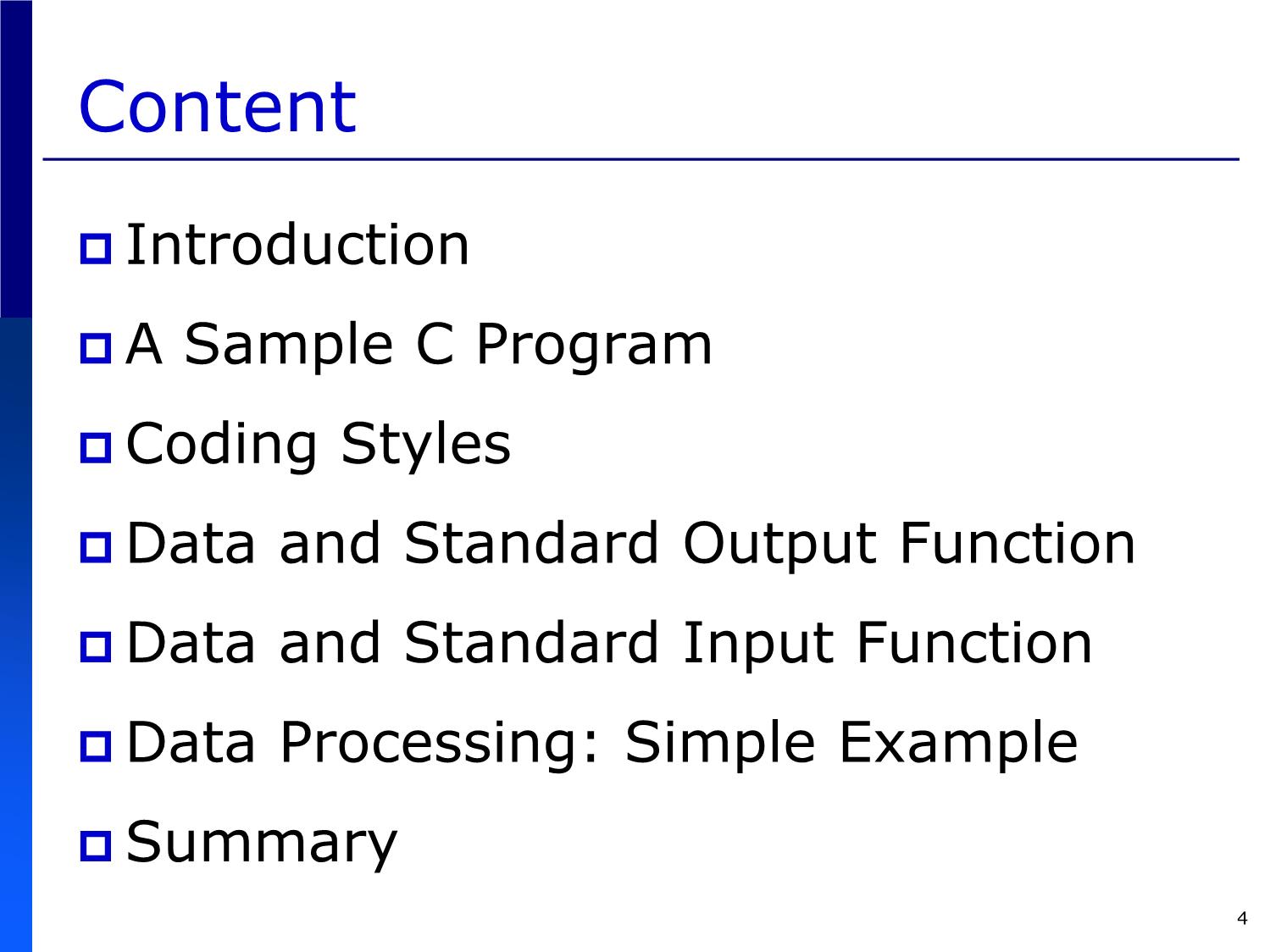
Trang 4
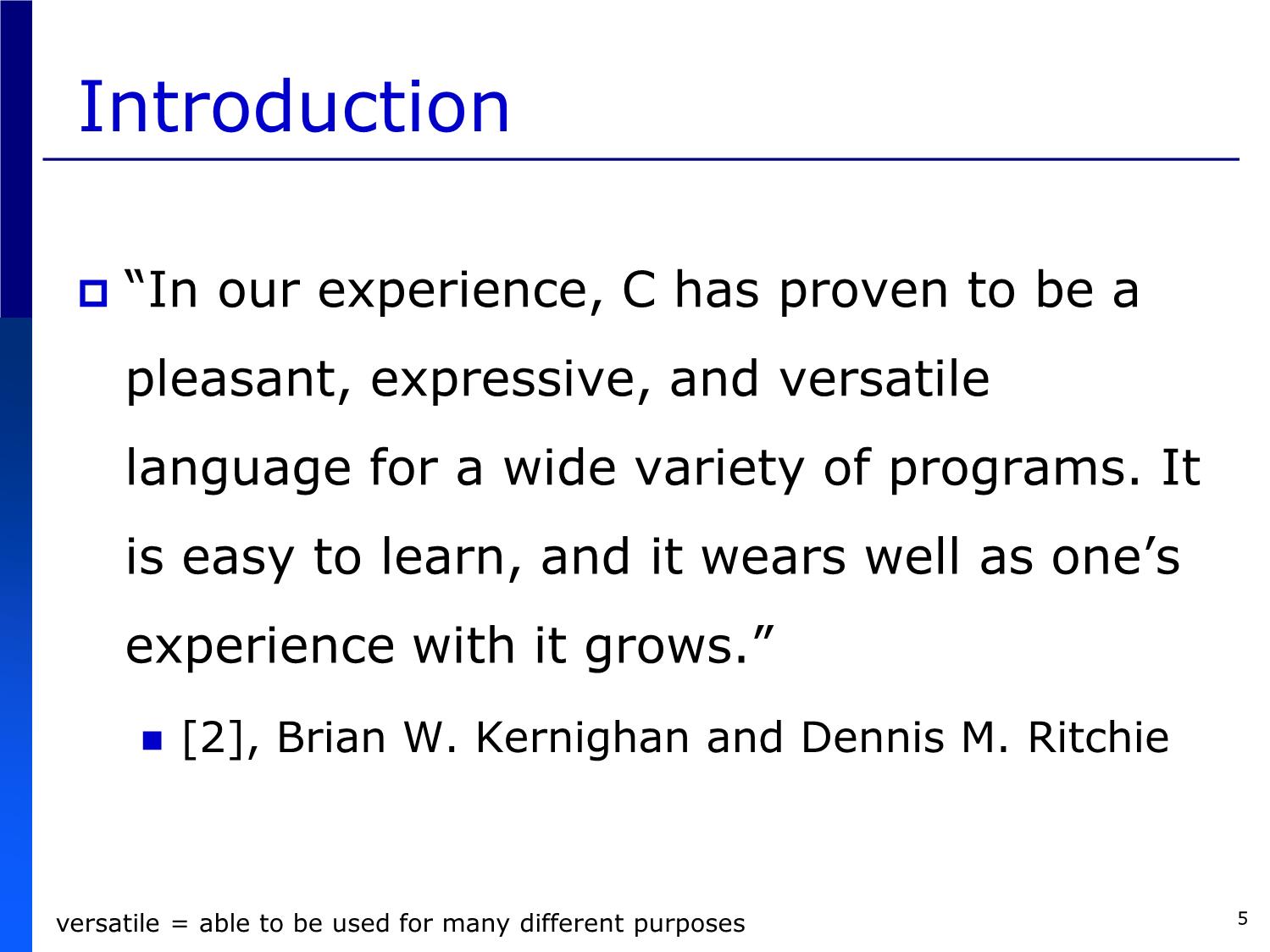
Trang 5
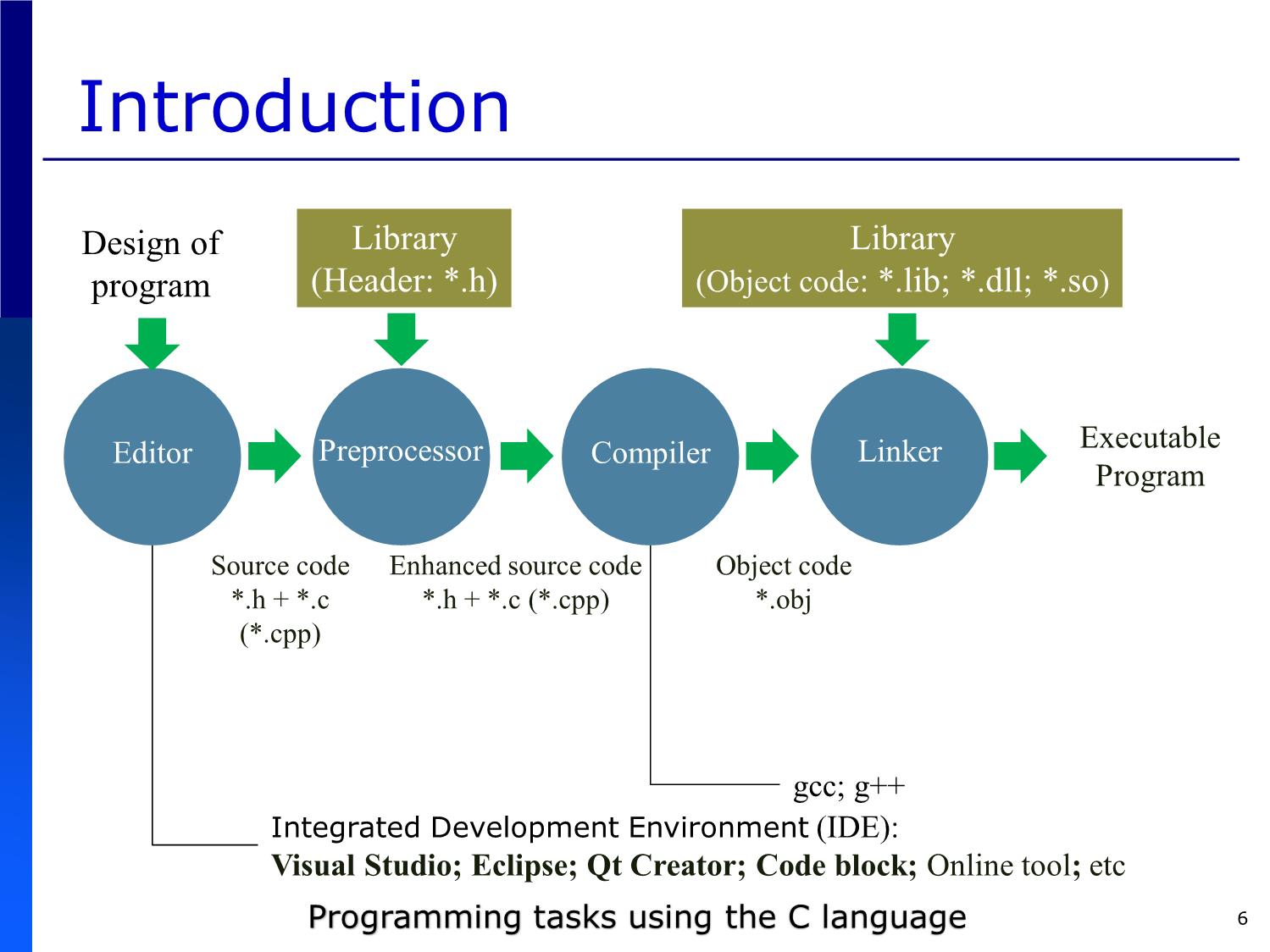
Trang 6
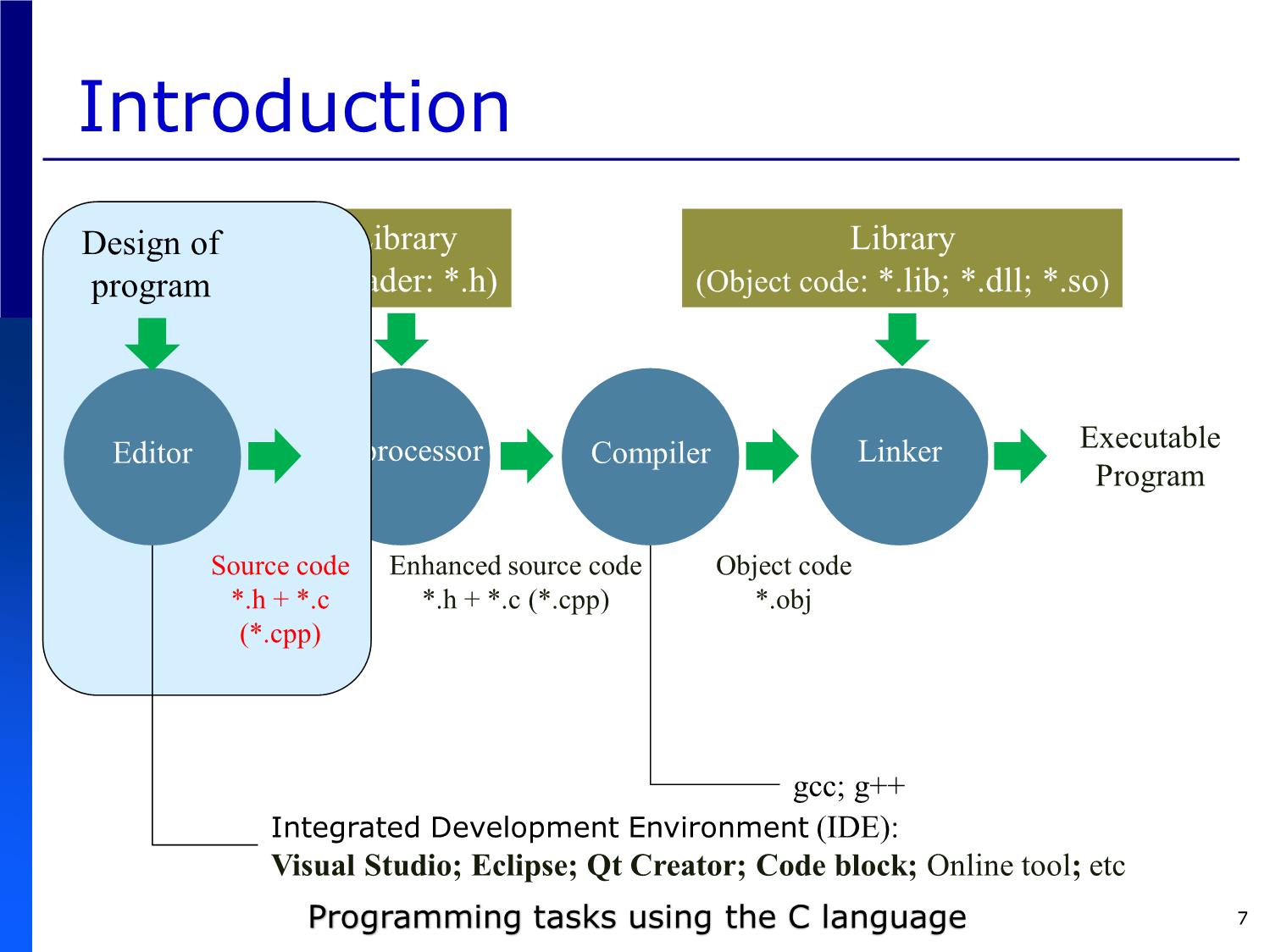
Trang 7

Trang 8

Trang 9

Trang 10
Tải về để xem bản đầy đủ
Bạn đang xem 10 trang mẫu của tài liệu "Bài giảng Introduction to Computer Programming (C language) - Chapter 2: C Program Structure and its Components - Võ Thị Ngọc Châu", để tải tài liệu gốc về máy hãy click vào nút Download ở trên
Tóm tắt nội dung tài liệu: Bài giảng Introduction to Computer Programming (C language) - Chapter 2: C Program Structure and its Components - Võ Thị Ngọc Châu

2012.
[2] “The C Programming Language”, 2nd Ed.
– Brian W. Kernighan and Dennis M. Ritchie,
Prentice Hall, 1988
and others, especially those on the Internet
3
Content
Introduction
A Sample C Program
Coding Styles
Data and Standard Output Function
Data and Standard Input Function
Data Processing: Simple Example
Summary
4
Introduction
―In our experience, C has proven to be a
pleasant, expressive, and versatile
language for a wide variety of programs. It
is easy to learn, and it wears well as one’s
experience with it grows.‖
[2], Brian W. Kernighan and Dennis M. Ritchie
versatile = able to be used for many different purposes 5
Introduction
Design of Library Library
program (Header: *.h) (Object code: *.lib; *.dll; *.so)
Editor Preprocessor Compiler Linker Executable
Program
Source code Enhanced source code Object code
*.h + *.c *.h + *.c (*.cpp) *.obj
(*.cpp)
gcc; g++
Integrated Development Environment (IDE):
Visual Studio; Eclipse; Qt Creator; Code block; Online tool; etc
Programming tasks using the C language 6
Introduction
Design of Library Library
program (Header: *.h) (Object code: *.lib; *.dll; *.so)
Editor Preprocessor Compiler Linker Executable
Program
Source code Enhanced source code Object code
*.h + *.c *.h + *.c (*.cpp) *.obj
(*.cpp)
gcc; g++
Integrated Development Environment (IDE):
Visual Studio; Eclipse; Qt Creator; Code block; Online tool; etc
Programming tasks using the C language 7
A Sample C Program
A source code file named C2_example1.c
Purpose: display our university’s name
and course’s name on the screen 8
A Sample C Program
A source code file named C2_example1.c
Purpose: display our university’s name
and course’s name on the screen 9
A Sample C Program
Every C program requires the specific
function named ―main‖ exactly.
The body of the
―main‖ function is
enclosed in the
brackets {}.
The body of the The specific
―main‖ function is A source code file named C2_example1.c extension of
made to serve the C source
specific purpose. Purpose: display our university’s name code files
and course’s name on the screen 10
A Sample C Program
A directive to the C preprocessor before the program is compiled.
is used for standard input/output library functions such
as the output function printf() and the input function scanf().
This global definition section is
used for external headers.
Comments in /**/ or after //
A source code file named C2_example1.c
Purpose: display our university’s name
and course’s name on the screen 11
A Sample C Program
File name: following the naming conventions
supported by the OS with the .c extension
Not include some special symbols: *, /, \,
Avoid using special symbols even if they are allowed
Prefer descriptive names
The ―main‖ function
All the files and libraries are compiled into a single
executable program file with exactly one ―main‖
function.
The starting point for the execution of a C program
Note: The C language is case-sensitive.
MAIN vs. Main vs. main
12
A Sample C Program
The ―main‖ function
void main(){ Open bracket ―{― to start the body section
} Corresponding close bracket ―}― to end the body
section
int main(void){
} Place for specifying the parameters of the function
Empty or void: no parameter is specified
Data type of the value returned by the ―main‖ function
int: a status value: 0 = no error; 1 = error
EXIT_SUCCESS = 0; EXIT_FAILURE = 1
void: no value is returned 13
A Sample C Program
The ―main‖ function
void main(){
printf("Ho Chi Minh City University of Technology\n"); statement
printf("Introduction to Computer Programming\n"); statement
}
Each statement
- ended with a semicolon (;)
- stretched on multiple lines with a backslash \ at the end
- able to be grouped in the brackets {}
- not consider spaces
Several statement types
- sequence: function calling, assignment, break, continue, return,
- selection: if, if else, switch
- repetition: for, while, do while 14
A Sample C Program
In addition to ―main‖, there are keywords/reserved words
in the C language.
[1], p. 42
15
A Sample C Program
The global definition section
Lines beginning with #
The #include directive tells the preprocessor to include
the contents of another file.
. #include ―myHeader.h‖
. A personal header file in the current directory
. #include
. A standard library file in the standard directory \include
The #define directive to set up symbolic replacements
The #if test at compile-time to look at the symbols in
#define and turn on and off which lines the compiler uses
Function prototypes to validate function calls
Global variable declarations
16
A Sample C Program
Comments
/**/: multi-line comment
//: single-line comment
17
A Sample C Program
How to get the program run for the specified purpose? *.c => a machine code file (e.g. *.exe)
A source code file named C2_example1.c
Purpose: display our university’s name
and course’s name on the screen 18
A Sample C Program
Edit:
C2_example1.c
Compile:
gcc –Wall C2_example1.c –o C2_example1
-Wall: display all the warning types along with the errors if any
-o C2_example1: specify a name for the resulting executable
program
Run:
C2_example1
19
A Sample C Program
GCC = GNU Compiler Collection
The free GNU C++: gcc.gnu.org/install/
binaries.html
GCC is available for most platforms,
including Linux, Mac OS X (via Xcode) and
Windows—via tools like Cygwin
(www.cygwin.com) and MinGW
(www.mingw.org)
Free IDEs: Micrsoft Visual Studio Express
Editions, CodeBlock, Dev C++,
20
Coding Styles
Which
(A)
one do
you
prefer?
(B)
(C) 21
Coding Styles
The three different formatted examples for
the same purpose return the same result:
What problems might we face with (A)?
What problems might we face with (B)?
What problems might we face with (C)?
What else if the program is not defined with
just a few lines; instead, with thousands of
lines?
22
Coding Styles
Alignment
Statements are aligned level by level based on
the block {} that they are contained.
Separation (White space)
Each statement should placed on a single line.
Blank lines should be used for more clarity.
Comment
A comment is added at any level for
explanation, marking, tracking,
Comments from the pseudo code helpful for
program development
Never abuse comments to make a program clear
23
Coding Styles
Naming conventions
Descriptive
Classified
Consistent
Agreements if any
Easy to remember, easy to be referred, easy to
be communicated
Less error-prone
24
Coding Styles
Naming conventions
What can you name in a C program except file
names?
Function: your defined modular processing unit
Variable: a location in memory where a value can be
stored for use by a program
Symbolic constant: constant represented as a symbol (a
string) that will be replaced with the value it stands for
A name should reflect the content and role of the
thing you define in a C program. 25
Coding Styles
Naming conventions
Create a name made up of at most 31 letters,
digits, underscore ―_‖ and starting with a letter
Consider verbs, nouns, phrases,
Consider a length of each name: short/long
Consider lower-case/upper-case letters
Consider prefix/suffix parts
Function: verb, phrase
Variable: noun, lower-case letters, short for loops
. Global variable: prefix g_
. Data type: suffix _ptr for pointers
Symbolic constant: upper-case letters, underscores 26
Coding Styles
Should Should not X
check_for_errors() error_checking()
dump_data_to_file()
is_any_upper_case() any_upper_case_test()
get_an_upper_case() return_an_upper_case()
set_first_upper_case() change_first_upper_case()
Student *student_prt; Student * student;
int g_thread_number; int thread_number;
static const double PI static const double Pi =
= 3.14; 3.14;
#define SIZE 10 #define size 10
27
Coding Styles
How to make the following program clearer?
28
Coding Styles
How to make the following program clearer?
29
Coding Styles
Check your naming conventions in your
pseudo code
How many names would you like to
rename?
What else have you changed on your
pseudo code?
How clearer is your pseudo code?
30
Coding Styles
Practice the formatting rules and conventions
to be part of your own coding habit
Make sure that your submitted programs are
always well-formatted
Make sure that your future programs are
readable, interpretable, able to be maintained,
reused, and extended
More information about coding styles at:
31
Data and Standard Output
Function
Standard output function: printf()
#include
Output the data to the standard output stream
A sequence of bytes flows from main memory to an
output device: display screen, printer, disk drive,
network connection, and so on.
Normally and automatically, the standard output
stream is connected to the screen.
Examples:
32
Data and Standard Output
Function
Formatting capabilities of the printf function
Rounding floating-point values to an indicated number
of decimal places.
Aligning a column of numbers with decimal points
appearing one above the other.
Right justification and left justification of outputs.
Inserting literal characters at precise locations in a
line of output.
Representing floating-point numbers in exponential
format.
Representing unsigned integers in octal and
hexadecimal format.
Displaying all types of data with fixed-size field widths
and precisions. 33
Data and Standard Output
Function
- format-control-string describes the output format.
- other-arguments (optional) correspond to each conversion
specification in format-control-string.
Each conversion specification begins with a percent sign (%) and
ends with a conversion specifier.
There can be many conversion specifications in one format control
string.
Examples:
The 1st conversion specification: %5.2f => argument: x
nd
The 2 conversion specification: %5.2f => argument: y 34
Data and Standard Output
Function
format-control-string is summarized as follows:
%[flag][width][.precision]specifier
specifier = d/i, u, o, x/X, f/F, e/E, g/G, a/A, c, s, p, n, %
precision = .number, .*
width = number, *
flag = +, -, space, #, 0
35
Data and Standard Output
Function
36
Data and Standard Output
Function
c Display a character.
s Display a sequence of characters until a terminating null \0
character is encountered.
37
Data and Standard Output
Function
Flags to supplement its output formatting capabilities,
placed immediately to the right of the percent sign
38
Data and Standard Output
Function
39
Data and Standard Output
Function
40
41
Data and Standard Output
Function
42
Data and Standard Input
Function
Standard input function: scanf()
#include
Input the data from the standard input stream
A sequence of bytes flows from an input device:
keyboard, disk drive, network connection, and so on to
main memory.
Normally and automatically, the standard input stream
is connected to the keyboard.
format-control-string describes the formats of the input.
other-arguments are pointers to variables in which the input will be stored.
43
Data and Standard Input
Function
The conversion specifiers used to input all types of data
44
Data and Standard Input
Function
The conversion specifiers used to input all types of data
45
Data and Standard Input
Function
The conversion specifiers used to input all types of data
Input data flow
from an input device
to main memory.
Input device = keyboard
Input
Input
Main memory ≈ variable ? 46
Data and Standard Input
Function
How to refer to the place in main memory
where the input data will be stored?
Memory is addressable contiguously.
Address is used!
Input a string: Input Input a character: A Input an integer: -123
Input device = keyboard Input device = keyboard Input device = keyboard
Input A -123
Input A -123
Main memory ≈ variable Main memory ≈ variable Main memory ≈ variable
Varying size: user-predefined Fixed sizes: character = 1 byte, integer = 4 bytes, 47
Data and Standard Input
Function
Input a string: Input Input a character: A Input an integer: -123
Input device = keyboard Input device = keyboard Input device = keyboard
Input A -123
Input A -123
Main memory ≈ variable Main memory ≈ variable Main memory ≈ variable
Varying size: user-predefined Fixed sizes: character = 1 byte, integer = 4 bytes,
char aString[5]; char aChar; int anInteger;
scanf(―%s‖, aString) scanf(―%c‖, &aChar) scanf(―%d‖, &anInteger)
printf(―%s‖, aString) printf(―%c‖, aChar) printf(―%d‖, anInteger)
In C, a string is defined as an array (sequence) of characters. The memory of this array
is referred by the address of the first character represented by the name of the array. 48
Data and Standard Input
Function
Put them altogether
49
Data and Standard Input
Function
Put them altogether
50
Data and Standard Input
Function
Input a date in the form of: dd/mm/yyyy
51
Data and Standard Input
Function
Input a date in the form of: dd Month yyyy
???
52
Data Processing: Simple Example
Program for computing the distance between
the center and a given point in a 2D space
Input: x, y as a coordinate of a given point
Output: the distance along with the given point
on screen
y
(3, 2)
0 x
Distance (i.e. the length of
the blue line) = 3.605551
53
Data Processing: Simple Example
Program for computing the distance between
the center and a given point in a 2D space
Input: x, y as a coordinate of a given point
Output: the distance along with the given point
on screen
54
Data Processing: Simple Example
printf() stdio.h
Function calling: scanf() stdio.h
sqrt() math.h
system() stdlib.h 55
Summary
Start programming with the C language
The components of a standard C program
Input & Output vs. Read & Write vs. scanf & printf
Make your programs not only executable but
also readable
Coding styles
56
Chapter 2: C Program Structure
and its Components
57 File đính kèm:
 bai_giang_introduction_to_computer_programming_c_language_ch.pdf
bai_giang_introduction_to_computer_programming_c_language_ch.pdf

